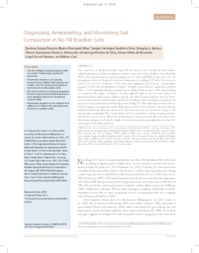Diagnosing, ameliorating, and monitoring soil compaction in no-till brazilian soils.
Diagnosing, ameliorating, and monitoring soil compaction in no-till brazilian soils.
Author(s): PEIXOTO, D. S.; SILVA, B. M.; SILVA, S. H. G.; KARLEN, D. L.; MOREIRA, S. G.; SILVA, A. A. P. da; RESENDE, A. V. de; NORTON, L. D.; CURI, N.
Summary: Soil compaction can significantly reduce crop yield. Our objective was to identify the most sensitive soil physical property and process indicators related to crop yield using a Random Forest algorithm (RFA). This machine-learning, decision-making tool was used with field-scale data from five soil management treatments designed to ameliorate compaction in no-tillage (NT) fields. The treatments were: T1, NT for 10 yr (control); T2, NT with surface application of 3.6 Mg ha-1 of agricultural gypsum; T3, NT with subsoiling plus 1.44 Mg ha-1 of highly reactive limestone applied to a depth of 0.60 m; T4, NT planting following chisel plowing at a depth of 0.26 m; and T5, NT with subsoiling to a depth of 0.60 m plus 1.44 Mg ha-1 of surface-applied, highly reactive limestone. Fifteen soil physical properties and processes related to growth and yield of soybean [Glycine max (L.) Merr.] were measured. Mechanical intervention, specifically subsoiling, improved soil physical properties and increased soybean yield cultivated following occasional tillage. The RFA ranked penetration resistance (PR), air capacity, macroporosity, relative field capacity, and the Dexter-S index as the most sensitive soil physical indicators affecting soybean yield. Those indicators were also sensitive to changes in soil structure due to subsoiling. We conclude that the RFA was an effective tool for screening indicators and that those chosen can be effective for monitoring soil compaction and its effect on soybean yield. Penetration resistance may be used to guide on-farm decision-making regarding when and how NT soil compaction should be addressed.
Publication year: 2019
Types of publication: Journal article
Unit: Embrapa Maize & Sorghum
Keywords: Compactação do Solo, Física do Solo, Plantio Direto, Random Forest, Rendimento
Observation
Some of Embrapa's publications are published as ePub files. To read them, use or download one of the following free software options to your computer or mobile device. Android: Google Play Books; IOS: iBooks; Windows and Linux: Calibre.
Access other publications
Access the Agricultural Research Database (BDPA) to consult Embrapa's full library collection and records.
Visit Embrapa Bookstore to purchase books and other publications sold by Embrapa.

